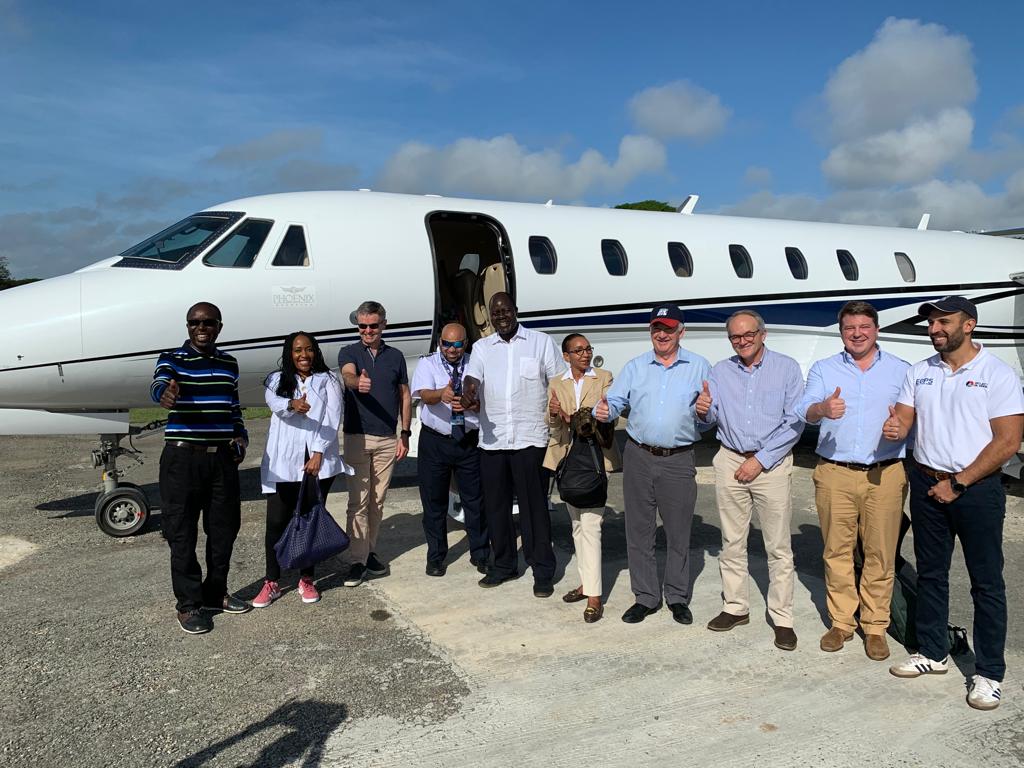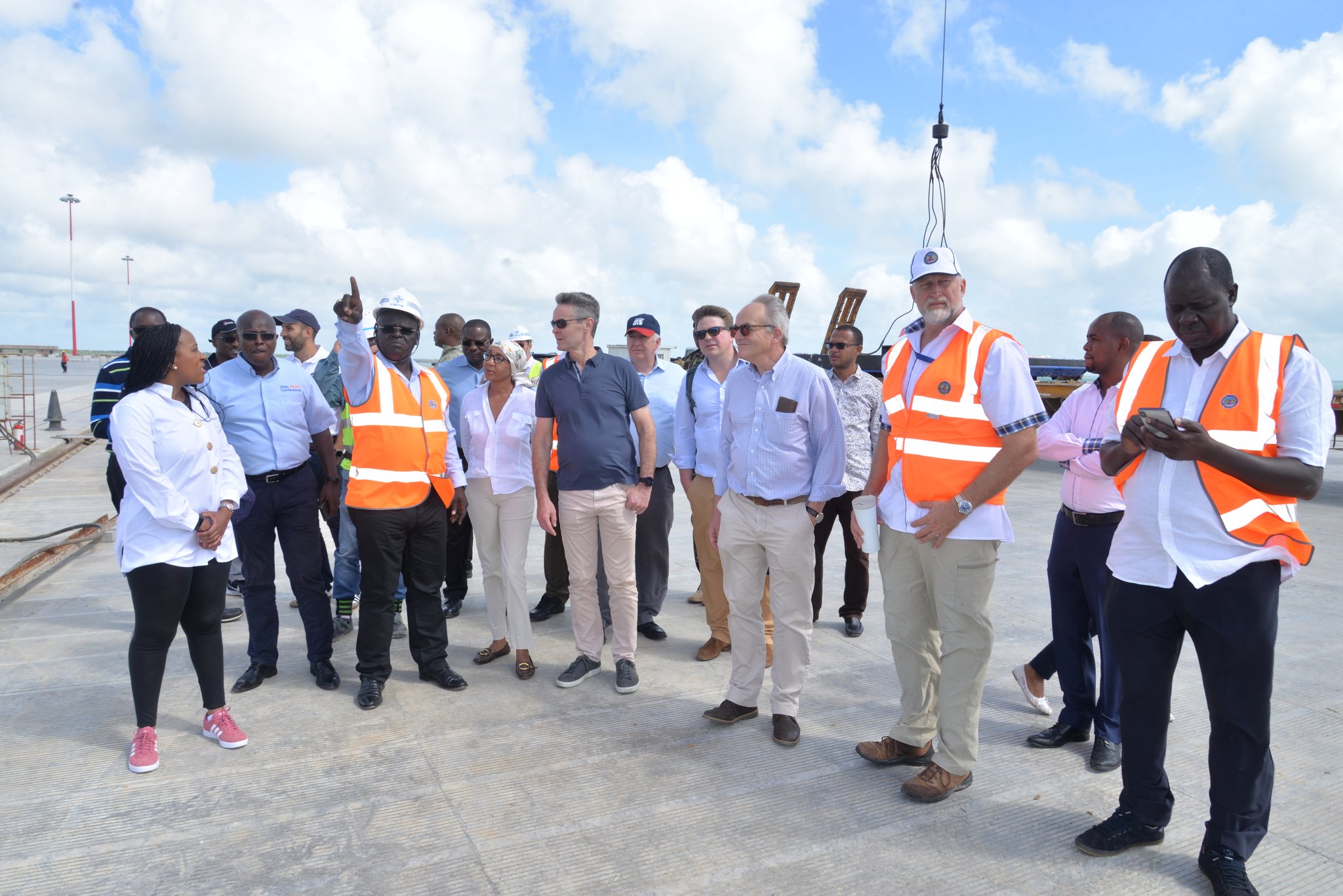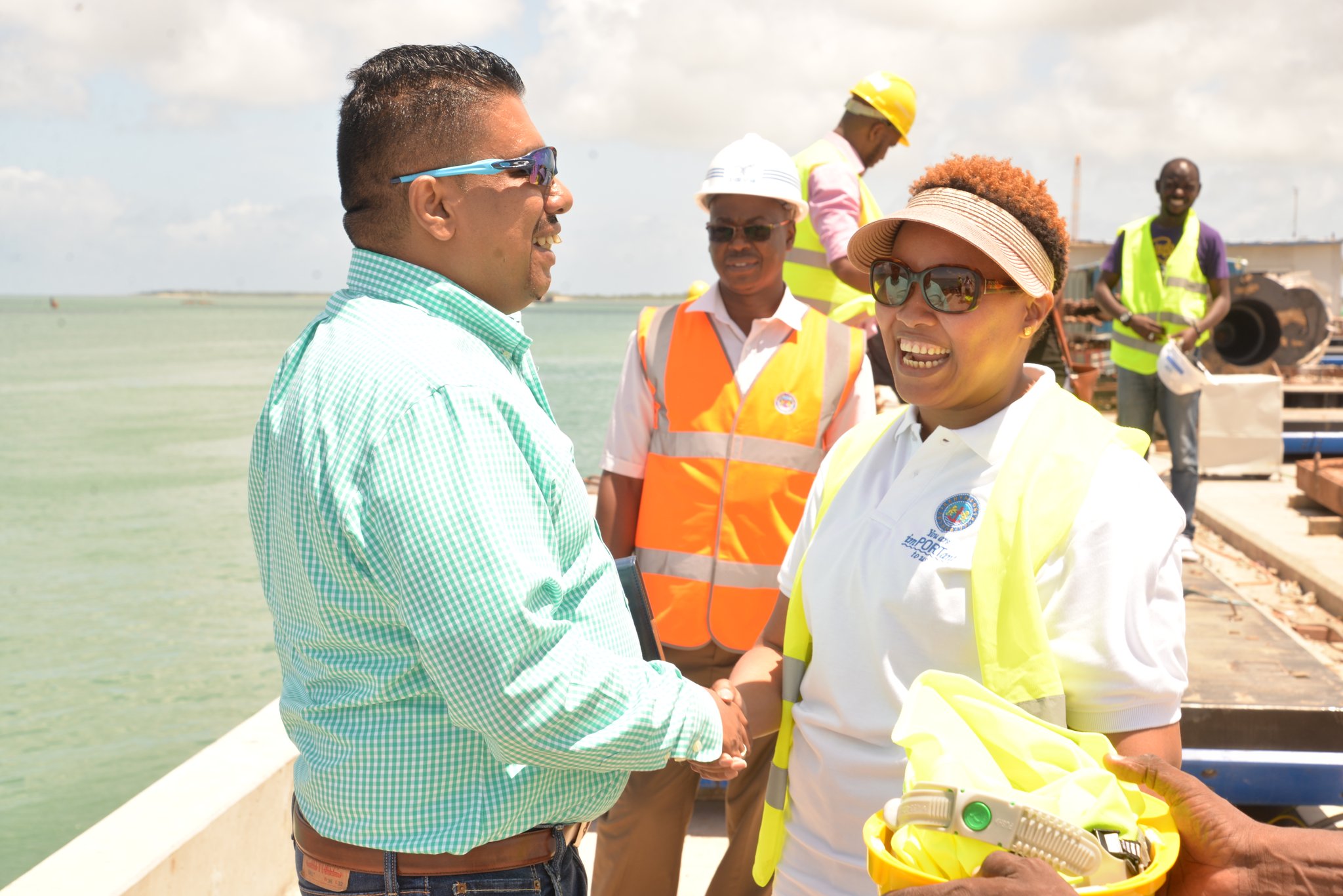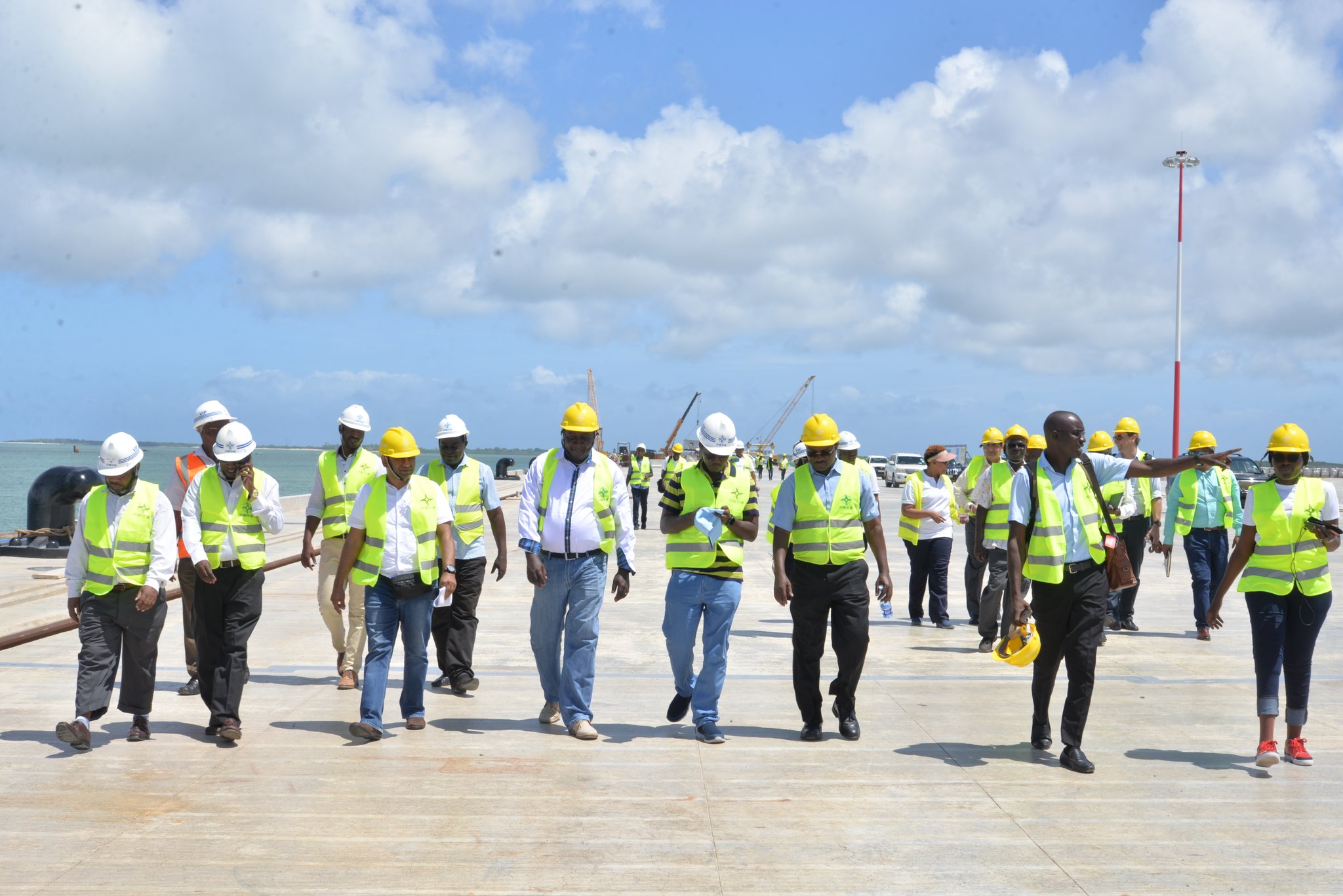Geza Ulole
JF-Expert Member
- Oct 31, 2009
- 59,186
- 79,378
Kenya banks on Lamu Port to gain regional shipping hub status
SUNDAY OCTOBER 27 2019

Ongoing construction of a second berth at Lamu Port. The first berth was completed by October and is set for official opening in November. PHOTO | TONY KARUMBA | AFP
In Summary

By ALLAN OLINGO
More by this Author
Kenya is betting on the multi-billion shilling Lamu Port to upset the power balance along Eastern Africa’s coast, setting Nairobi up for battle with the Port of Djibouti and the planned Bagamoyo harbour in Tanzania.
The first berth of the Ksh32 billion ($320 million ) Lamu Port is set for official opening next month, with Kenya hoping to make it the region’s transshipment hub.
The strategically located Port of Djibouti already controls transshipment business in the region, with Tanzania’s Bagamoyo port, whose takeoff has delayed over contractual concerns, now left to play catch up as Lamu's business comes to life.
Tanzania is also undertaking a $345 million World Bank funded Dar es Salaam Maritime Gateway Project (DSMGP).
Kenya’s President Uhuru Kenyatta is, in a few weeks, expected to commission the first of the 32 berths of a trans-African Lamu Port, when the first Neo-Panamax ship is expected to dock.
“Lamu will play host to the newest port on the African East coast. The Lamu Port will begin its operations, initially as a transshipment hub for global shipping lines. It will be supported by a special economic zone that is expected to attract investors from across the world, to undertake various economic activities.
“Our aim is to make Lamu Port the port of choice for the export of Kenya’s crude oil,” President Kenyatta said in his October 20 Mashujaa Day address to the nation.
For Nairobi, this is a big gamble, as the country looks to become the Eastern Africa trans-shipment powerhouse. The country hopes to do this by taking advantage of Lamu Port’s 18 metres natural draft, capable of accommodating the increasingly huge maritime vessels.
“We intend to make Lamu a transshipment hub for the East African region, and the larger horn of Africa. Currently, our Kilindini port cannot handle a Suezmax, Neo-Panamax or Chinamax class vessels, because of its shallow depths,” the Kenya Ports Authority (KPA) managing director Daniel Manduku told The EastAfrican.
For Kenya, the docking of such size of ships capable of carrying more than 20,000 twenty foot equivalents (TEU’s) will be a game changer.
Djibouti, with its two ports of Dolareh and the Port of Djibouti, currently handles the largest cargo volumes in the region averaging three million tonnes annually.
“When you look at our data, the transshipment traffic to Mombasa Port doubled to 1.3 million tonnes in the seven months of this year, from 624,000 tonnes over a similar period in 2018, showing the business opportunity for the Lamu port,” said Mr Manduku.
Original plan
Cargo coming into the region from China, currently East Africa’s biggest import source, docks at Singapore and is then offloaded to smaller ships en-route to Mombasa. Those coming from Europe dock at Omans’ Salala port, before they are shipped to the region.
“With the Lamu port, we aim to remove this barrier, which is costly and time-wasting for shippers,” added Mr Manduku.
The Lamu Port has already attracted the attention of regional neighbours hosting envoys and delegations from Uganda, Ethiopia, South Sudan and the Democratic Republic of Congo (DRC).
Launched nine years ago, the multi-billion-dollar project entailed building link roads between the Kenya and Ethiopia, a pipeline to Kenya’s northern frontier of Turkana, an international airport in Isiolo town and a sea port in Lamu.
Under its original plan, the Lamu Port, South Sudan, Ethiopia Transport (Lapsset) plan included a 32-berth port, transportation hubs for rail, highway and international airports in Lamu, Isiolo and Lodwar, an oil pipeline from South Sudan, Uganda and Ethiopia to Lamu Port, an oil refinery and three resort cities in Isiolo, Lamu and Turkana, in northern Kenya.
Kenya’s Cabinet Secretary for transport and infrastructure James Macharia said with the completion of the access roads leading to the northern frontier, they will expect the port to eventually serve as far as Congo Brazzaville.
“We have worked hard to make sure that the Northern corridors infrastructure is up to date. This has been very deliberate so that we position the country’s bespoke port services, with requisite supporting infrastructure. We expect the port to comfortably serve South Sudan, Congo-Brazzaville, DR Congo and other East African countries,” Mr Macharia said.
Infrastructure investments
A recent report by the Japan International Co-operation Agency showed that the cost of transport in landlocked countries reduced by more than 16 per cent due to infrastructure investments and cross border trade facilitations along Kenya’s Northern corridor.
“We have introduced reforms in the Northern Corridor including the introduction of motion weighbridges and reduction of the number of border points thus increasing number of turnaround of trucks. With the connection of interlink roads between Lamu and this corridor, we now expect to position ourselves between the competitors,” Mr Macharia said.
The Ticad report ranked the Port of Mombasa fifth in Africa after Egypt’s Port Said, Durban in South Africa, Tanger Med in Morocco, and Alexandria in Egypt with Port of Dar reported to have handled only 60 per cent of what is currently being handled in Mombasa.
For Lamu, the headache now remains the transit cargo shipments, as the supporting roads outside of the port remain incomplete and behind schedule.
For example, the Garissa-Isiolo road is yet to start, even after re-assurances that it "would start this year," with only three months left of 2019.
Other associated road infrastructure projects in the ongoing construction of the $108 million Lamu-Garsen road are behind schedule with its construction being 30 per cent complete, as its December completion deadline looks unattainable.
This means that the haulage of any goods landing at the port this year will not be possible, leaving the port to only do transshipment business, for the start.
Shippers, already aware of the poor supporting road infrastructure around the Lamu port have already raised concern, noting that “there was need to invest more on infrastructure to make the port more attractive to investors.”
“The government needs to work on the inland operations cost to make Lamu Port more attractive to shippers and other investors,” Shippers Council of East Africa chief executive Gilbert Lagat said.
“Most of shippers consider end-to-end cost before venturing in any business hence there is a need for the government to speed up the process of improving other infrastructure to make movement of goods cheaper.
“We have seen KPA advertised promotional tariffs to entice more shipping lines and agents to use the facility but that is not enough as we consider other cargo handling cost from the port to its final destination which is mostly either Nairobi or Uganda, but without good roads or railway, the deal would not be attractive to many.”
Security headache
Lamu’s close proximity to the terrorist group Al-Shabab’s Somalia base also poses a security headache for the port’s management.
The Lapsset CEO Silvester Kasuku said Kenya has deployed the Navy and Coast Guard at the port, the Army at Baragoni Police besides other security formations including a GSU camp. He also said the channel that ships use will be guarded by navy patrols.
The recent changes in the regional political landscape, especially within the horn of Africa, has also seen Ethiopia-the project’s biggest backer at its launch in 2012- make peace with Eritrea and also invest hundreds of millions of dollars in several ports in Djibouti and Somaliland.
Addis has also acquired stakes in the Djibouti port of Doraleh, Port of Djibouti, Khartoum’s largest seaport, Port Sudan. Its $80 million investment for a 19 percent stake in Somaliland’s Port of Berbera and its recent announcement that it is also seeking a stake in Eritrea Port leaves the Lamu port business model exposed.
“The Ethiopia/Eritrea peace deal will have no negative implications on this project. Lamu Port will strategically be located to service southern Ethiopia which alone has about 50 million people even when the country has access to Eritrean and Djiboutian ports.
“The two ports will actively handle North of Addis Ababa,” Sylvester Kasuku, the chief executive officer of Lamu Port-South Sudan-Ethiopia-Transport (Lapsset) Corridor project said.
In 2017, and to entice Ethiopia, Kenya offered land to enable Ethiopia set up a logistics facility at the Lamu Port, in the clearest indication that the Ethiopia was eyeing the Kenyan port for its import and export activities.
Outside of transshipment, Kenya is also angling to have a crude oil dedicated berth for the port, as it actualises its pipeline project from Turkana.
Berth three has already been reserved as a fuel dedicated berth.
“We are hoping to have both Berth two and three ready by the end of next year. The cabinet recently approved for the petroleum ministry to take charge of Berth 3, and link it with the Lamu-Turkana pipeline to help us ship out our crude oil,” Mr Macharia said.
Kenya’s game plan is to have on board South Sudan, and possibly Uganda, to use the pipeline facility, and berth three to export their crude oil once the projects has been commissioned.
In June, Kenya signed agreements with Total, Tullow Oil and Africa Oil Corp to develop a 60,000 to 80,000 barrels-per-day crude processing facility for oil discovered in Lokichar, northern Kenya. It is now expected that the berth will play host to this facility, among other supporting oil infrastructure.
“The infrastructure installed for the foundation stage will be utilised for the development of the remaining oil fields and future oil discoveries in the region, allowing the incremental development of these fields to be completed at a lower unit cost,” Tullow Kenya said.

 www.theeastafrican.co.ke
www.theeastafrican.co.ke
SUNDAY OCTOBER 27 2019

Ongoing construction of a second berth at Lamu Port. The first berth was completed by October and is set for official opening in November. PHOTO | TONY KARUMBA | AFP
In Summary
- The first berth of the Lamu Port is set for official opening next month, with Kenya hoping to make it the region’s transshipment hub.
- The strategically located Port of Djibouti already controls transshipment business in the region, with Tanzania’s Bagamoyo port now left to play catch up as Lamu's business comes to life.
- Djibouti currently handles the largest cargo volumes in the region averaging three million tonnes annually.

By ALLAN OLINGO
More by this Author
Kenya is betting on the multi-billion shilling Lamu Port to upset the power balance along Eastern Africa’s coast, setting Nairobi up for battle with the Port of Djibouti and the planned Bagamoyo harbour in Tanzania.
The first berth of the Ksh32 billion ($320 million ) Lamu Port is set for official opening next month, with Kenya hoping to make it the region’s transshipment hub.
The strategically located Port of Djibouti already controls transshipment business in the region, with Tanzania’s Bagamoyo port, whose takeoff has delayed over contractual concerns, now left to play catch up as Lamu's business comes to life.
Tanzania is also undertaking a $345 million World Bank funded Dar es Salaam Maritime Gateway Project (DSMGP).
Kenya’s President Uhuru Kenyatta is, in a few weeks, expected to commission the first of the 32 berths of a trans-African Lamu Port, when the first Neo-Panamax ship is expected to dock.
“Lamu will play host to the newest port on the African East coast. The Lamu Port will begin its operations, initially as a transshipment hub for global shipping lines. It will be supported by a special economic zone that is expected to attract investors from across the world, to undertake various economic activities.
“Our aim is to make Lamu Port the port of choice for the export of Kenya’s crude oil,” President Kenyatta said in his October 20 Mashujaa Day address to the nation.
For Nairobi, this is a big gamble, as the country looks to become the Eastern Africa trans-shipment powerhouse. The country hopes to do this by taking advantage of Lamu Port’s 18 metres natural draft, capable of accommodating the increasingly huge maritime vessels.
“We intend to make Lamu a transshipment hub for the East African region, and the larger horn of Africa. Currently, our Kilindini port cannot handle a Suezmax, Neo-Panamax or Chinamax class vessels, because of its shallow depths,” the Kenya Ports Authority (KPA) managing director Daniel Manduku told The EastAfrican.
For Kenya, the docking of such size of ships capable of carrying more than 20,000 twenty foot equivalents (TEU’s) will be a game changer.
Djibouti, with its two ports of Dolareh and the Port of Djibouti, currently handles the largest cargo volumes in the region averaging three million tonnes annually.
“When you look at our data, the transshipment traffic to Mombasa Port doubled to 1.3 million tonnes in the seven months of this year, from 624,000 tonnes over a similar period in 2018, showing the business opportunity for the Lamu port,” said Mr Manduku.
Original plan
Cargo coming into the region from China, currently East Africa’s biggest import source, docks at Singapore and is then offloaded to smaller ships en-route to Mombasa. Those coming from Europe dock at Omans’ Salala port, before they are shipped to the region.
“With the Lamu port, we aim to remove this barrier, which is costly and time-wasting for shippers,” added Mr Manduku.
The Lamu Port has already attracted the attention of regional neighbours hosting envoys and delegations from Uganda, Ethiopia, South Sudan and the Democratic Republic of Congo (DRC).
Launched nine years ago, the multi-billion-dollar project entailed building link roads between the Kenya and Ethiopia, a pipeline to Kenya’s northern frontier of Turkana, an international airport in Isiolo town and a sea port in Lamu.
Under its original plan, the Lamu Port, South Sudan, Ethiopia Transport (Lapsset) plan included a 32-berth port, transportation hubs for rail, highway and international airports in Lamu, Isiolo and Lodwar, an oil pipeline from South Sudan, Uganda and Ethiopia to Lamu Port, an oil refinery and three resort cities in Isiolo, Lamu and Turkana, in northern Kenya.
Kenya’s Cabinet Secretary for transport and infrastructure James Macharia said with the completion of the access roads leading to the northern frontier, they will expect the port to eventually serve as far as Congo Brazzaville.
“We have worked hard to make sure that the Northern corridors infrastructure is up to date. This has been very deliberate so that we position the country’s bespoke port services, with requisite supporting infrastructure. We expect the port to comfortably serve South Sudan, Congo-Brazzaville, DR Congo and other East African countries,” Mr Macharia said.
Infrastructure investments
A recent report by the Japan International Co-operation Agency showed that the cost of transport in landlocked countries reduced by more than 16 per cent due to infrastructure investments and cross border trade facilitations along Kenya’s Northern corridor.
“We have introduced reforms in the Northern Corridor including the introduction of motion weighbridges and reduction of the number of border points thus increasing number of turnaround of trucks. With the connection of interlink roads between Lamu and this corridor, we now expect to position ourselves between the competitors,” Mr Macharia said.
The Ticad report ranked the Port of Mombasa fifth in Africa after Egypt’s Port Said, Durban in South Africa, Tanger Med in Morocco, and Alexandria in Egypt with Port of Dar reported to have handled only 60 per cent of what is currently being handled in Mombasa.
For Lamu, the headache now remains the transit cargo shipments, as the supporting roads outside of the port remain incomplete and behind schedule.
For example, the Garissa-Isiolo road is yet to start, even after re-assurances that it "would start this year," with only three months left of 2019.
Other associated road infrastructure projects in the ongoing construction of the $108 million Lamu-Garsen road are behind schedule with its construction being 30 per cent complete, as its December completion deadline looks unattainable.
This means that the haulage of any goods landing at the port this year will not be possible, leaving the port to only do transshipment business, for the start.
Shippers, already aware of the poor supporting road infrastructure around the Lamu port have already raised concern, noting that “there was need to invest more on infrastructure to make the port more attractive to investors.”
“The government needs to work on the inland operations cost to make Lamu Port more attractive to shippers and other investors,” Shippers Council of East Africa chief executive Gilbert Lagat said.
“Most of shippers consider end-to-end cost before venturing in any business hence there is a need for the government to speed up the process of improving other infrastructure to make movement of goods cheaper.
“We have seen KPA advertised promotional tariffs to entice more shipping lines and agents to use the facility but that is not enough as we consider other cargo handling cost from the port to its final destination which is mostly either Nairobi or Uganda, but without good roads or railway, the deal would not be attractive to many.”
Security headache
Lamu’s close proximity to the terrorist group Al-Shabab’s Somalia base also poses a security headache for the port’s management.
The Lapsset CEO Silvester Kasuku said Kenya has deployed the Navy and Coast Guard at the port, the Army at Baragoni Police besides other security formations including a GSU camp. He also said the channel that ships use will be guarded by navy patrols.
The recent changes in the regional political landscape, especially within the horn of Africa, has also seen Ethiopia-the project’s biggest backer at its launch in 2012- make peace with Eritrea and also invest hundreds of millions of dollars in several ports in Djibouti and Somaliland.
Addis has also acquired stakes in the Djibouti port of Doraleh, Port of Djibouti, Khartoum’s largest seaport, Port Sudan. Its $80 million investment for a 19 percent stake in Somaliland’s Port of Berbera and its recent announcement that it is also seeking a stake in Eritrea Port leaves the Lamu port business model exposed.
“The Ethiopia/Eritrea peace deal will have no negative implications on this project. Lamu Port will strategically be located to service southern Ethiopia which alone has about 50 million people even when the country has access to Eritrean and Djiboutian ports.
“The two ports will actively handle North of Addis Ababa,” Sylvester Kasuku, the chief executive officer of Lamu Port-South Sudan-Ethiopia-Transport (Lapsset) Corridor project said.
In 2017, and to entice Ethiopia, Kenya offered land to enable Ethiopia set up a logistics facility at the Lamu Port, in the clearest indication that the Ethiopia was eyeing the Kenyan port for its import and export activities.
Outside of transshipment, Kenya is also angling to have a crude oil dedicated berth for the port, as it actualises its pipeline project from Turkana.
Berth three has already been reserved as a fuel dedicated berth.
“We are hoping to have both Berth two and three ready by the end of next year. The cabinet recently approved for the petroleum ministry to take charge of Berth 3, and link it with the Lamu-Turkana pipeline to help us ship out our crude oil,” Mr Macharia said.
Kenya’s game plan is to have on board South Sudan, and possibly Uganda, to use the pipeline facility, and berth three to export their crude oil once the projects has been commissioned.
In June, Kenya signed agreements with Total, Tullow Oil and Africa Oil Corp to develop a 60,000 to 80,000 barrels-per-day crude processing facility for oil discovered in Lokichar, northern Kenya. It is now expected that the berth will play host to this facility, among other supporting oil infrastructure.
“The infrastructure installed for the foundation stage will be utilised for the development of the remaining oil fields and future oil discoveries in the region, allowing the incremental development of these fields to be completed at a lower unit cost,” Tullow Kenya said.

Kenya banks on Lamu Port to gain regional shipping hub status
New harbour puts Nairobi head-to-head with Tanzania and Djibouti.


















